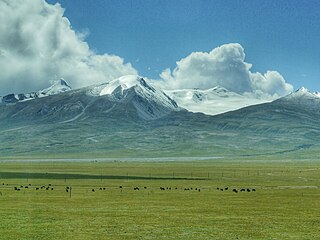
The Brahmaputra is a trans-boundary river which flows through Tibet (China), Northeastern India, and Bangladesh. It is known as Brahmaputra or Luit in Assamese,Yarlung Tsangpo in Tibetan, the Siang/Dihang River in Arunachali and Jamuna River in Bengali. It is the 9th largest river in the world by discharge, and the 15th longest.

The Yarlung Tsangpo Grand Canyon, also known as the Yarlung Zangbo Grand Canyon, the Tsangpo Canyon, the Brahmaputra Canyon or the Tsangpo Gorge, is a canyon along the Yarlung Tsangpo River in Tibet Autonomous Region, China. It is the deepest canyon in the world, and at 504.6 kilometres (313.5 mi) is slightly longer than the Grand Canyon in the United States, making it one of the world's largest. The Yarlung Tsangpo originates near Mount Kailash and runs east for about 1,700 kilometres (1,100 mi), draining a northern section of the Himalayas before it enters the gorge just downstream of Pei, Tibet, near the settlement of Zhibe. The canyon has a length of about 240 kilometres (150 mi) as the gorge bends around Mount Namcha Barwa and cuts its way through the eastern Himalayan range. Its waters drop from about 2,900 metres (9,500 ft) near Pei to about 1,500 metres (4,900 ft) at the end of the Upper Gorge where the Po Tsangpo River enters. The river continues through the Lower Gorge to the Indian border at an elevation of 660 metres (2,170 ft). The river then enters Arunachal Pradesh and eventually becomes the Brahmaputra.
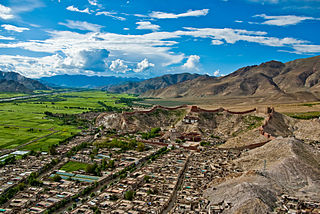
Gyantse, officially Gyangzê Town, is a town located in Gyantse County, Shigatse Prefecture, Tibet Autonomous Region, China. It was historically considered the third largest and most prominent town in the Tibet region, but there are now at least ten larger Tibetan cities.

The Friendship Highway is an 800-kilometre (500 mi) scenic route connecting the capital of Tibet, Lhasa, with the Chinese/Nepalese border at the Sino-Nepal Friendship Bridge between Zhangmu and Kodari. It includes the westernmost part of China National Highway 318 (Shanghai-Zhangmu) and crosses three passes over 5,000 m (16,400 ft) before dropping to 1,750 m (5,700 ft) at the border.

Lake Pelku, Pelkhu, or Paiku is a lake at 4,591 meters (15,062 ft) elevation on the Tibetan Plateau in Shigatse Prefecture. It is 18 kilometers (11 mi) south of the Yarlung Tsangpo (Brahmaputra) River, bordering Saga County, Gyirong County, and Nyalam County.
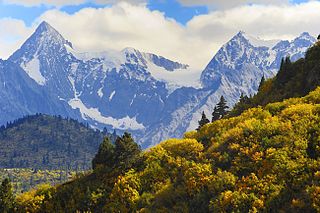
Pasho County or Baxoi County is a county under the administration of Chamdo Prefecture in the Tibet Autonomous Region, China. The county seat is at Pema, which is also called the "Pasho Town". The county population is 35,273 (1999). It contains the Pomda Monastery and Rakwa Tso lake.

Bayi or Chagyib District, formerly Nyingchi County, is a District of Nyingchi in the Tibet Autonomous Region, China. Bayi Town, the administrative capital of Nyingchi, is located within the district.

Pome County or Bomê County is a county of Nyingchi Prefecture in the south-east of the Tibet Autonomous Region. Historically known as Powo or Poyul, it was the seat of a quasi-independent kingdom until the early 20th century when troops of the Dalai Lama's Lhasa government integrated it into the central Tibetan realm. The population was 25,897 in 2004.

Lamaling Monastery, also known as Zangdrok Pelri Monastery and Burqug Lamaling (布久喇嘛林寺), is a Buddhist monastery located near the village of Jianqie, Burqug Township, Bayi District, in Tibet, on a small hill 1.5 km south of Buchu Monastery. The monastery belongs to the Nyingmapa sect, translated as the ‘Ancient Ones’; their lineages go back to the first infusion of Buddhism from India to Tibet in the 7th century CE. The Nyingma sect incorporated many of the traditions of the native Tibetan Bon religion, which respects nature and local nature spirits.

The new town of Lhatse or Lhatse Xian, also known as Quxar (Tibetan: ཆུ་ཤར་, Quxia, or Chusar, is a small town of a few thousand people in the Tibet Autonomous Region in the valley of the Yarlung Tsangpo River in Lhatse County, 151 kilometres southwest of Shigatse and just west of the mountain pass leading to it. Lhatse is 4,050 metres above sea-level.

The Yarlung Tsangpo, also called Yarlung Zangbo and Yalu Zangbu River is the upper stream of the Brahmaputra River located in the Tibet Autonomous Region, China. It is the longest river of Tibet and the fifth longest in China. The upper section is also called Dangque Zangbu meaning "Horse River."
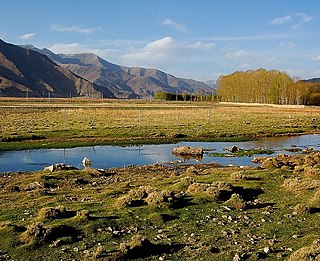
Kongpo is a region of central-eastern Tibet, centered in modern Gongbo'gyamda County, Nyingchi Prefecture. It is situated on the Nyang River, a northern tributary of the Yarlung Tsangpo River.

The Valley of the Kings or Chongye Valley branches off the Yarlung Valley to the southwest and contains a series of graveyard tumuli, approximately 27 kilometres (17 mi) south of Tsetang, Tibet, near the town of Qonggyai on Mure Mountain in Qonggyai County of the Shannan Prefecture.
Daklha Gampo Monastery, also romanized as Daglha Gampo, is a Kagyu Tibetan Buddhist monastery founded in 1121 CE by Je Gampopa (1079-1153), the disciple of the famous and much-loved bodhisattva, Jetsun Milarepa It is located in Gyatsa County in the old district of Dakpo in southern Tibet on land sanctified as a geomantic power-place by the first Tibetan emperor, Songtsen Gampo, and made a repository of terma by Padmasambhava.

Bayi or Chagyib is a subdistrict in Tibet Autonomous Region, China and seat of Bayi District, Nyingchi. It lies on the Nyang River at an altitude of 2,994 metres. Bayi is an important timber and wool producing town, known historically before the 1960s as Lhabagar. By road it is 405 kilometres (252 mi) east of Lhasa on the way to Chengdu.

The Yarlung Valley is formed by Yarlung Chu, a tributary of the Tsangpo River in the Shannan Prefecture in the Tibet region of China. It refers especially to the district where Yarlung Chu joins with the Chongye River, and broadens out into a large plain about 2 km wide, before it flows into the Tsangpo River. It is situated in Nedong District of the Shannan Prefecture and includes the capital of the prefecture, Tsetang, one of Tibet's largest cities, 183 km southeast of Lhasa.
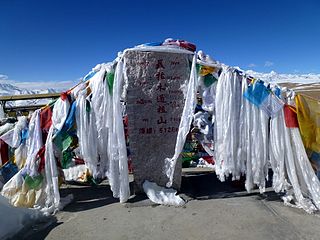
Nyalam Tong La or Yakrushong La is a mountain pass in China on the Matsung Tsangpo-Phung Chhu watershed divide where the Friendship Highway connecting Kathmandu, Nepal and Lhasa, Tibet crosses at 5,150 metres (16,900 ft) elevation.

The Yarlung Tsangpo arid steppe ecoregion covers the river valley of the Yarlung Tsangpo River on the southern edge of Tibet. The river runs parallel to the northern borders of Nepal, Bhutan and India, between the Himalayas to the south and the Tibet Plateau to the north. The river valleys are the most populated areas of Tibet, putting pressure on wildlife. The area ranges from cold desert in the west to steppe shrub land in the east; the few trees are in the lowest river valleys to the east.
Nyamjang Chu, or Nyashang Chu (Tibetan: ཉ་བཤང་ཆུ, Wylie: nya bshang chu, THL: nya shang chu) is a cross-border perennial river that originates in the Shannan Prefecture of Tibet and flows into the Arunachal Pradesh state of India, joining the Tawang Chu river just before it enters Bhutan. The Nyamjang Chu valley has provided the traditional communication route between Tawang and Tibet. The valley near town of Zemithang in the Tawang district, called the Pangchen Valley, is known for its serene beauty and forms one of the wintering locations for the black-necked crane.






